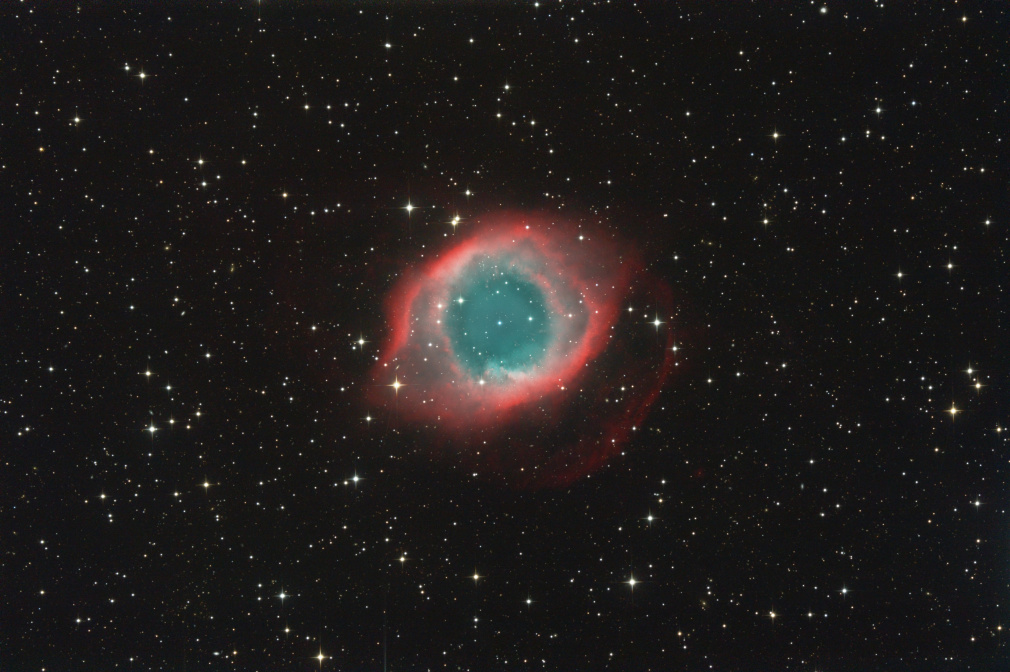The appearance of Helix Nebula resembles a helix, viewed from above, close to its axis, hence the name.
The Helix Nebula (NGC7293) was discovered in the first part of the 19th century by German astronomer Karl Ludwig Harding, who is also known as the one who discovered Juno, the third known asteroid in the Solar System.
The Helix Nebula is one of the closest planetary nebulae, its distance is about 700 light-years only, and its dimension is 2.5 light-years approximately. The age of Helix Nebula was estimated to be 11000 years, based on its expansion rate measured in 2002.
 Planetary nebulae are special kind of emission nebulae. The misleading name comes from the golden era of deep-sky discoveries. In those days the real nature of these small appearing objects were not yet known, but they resembled planets when looked at with a telescope, hence the name. Larger emission nebulae consist of hydrogen usually, with recent star formation in them. The newly born hot stars are ionising the remains of the cloud, making it glow in red. Planetary nebulae are much smaller, and in opposition, are related to the death of stars. When the concentration of hydrogen needed for the primary fusion producing helium from hydrogen in the core of a star drops below a critical level, the outward pressure fuelled by this fusion cannot hold against the gravity of the star, and the core starts contracting. Temperature and pressure in the core rises quickly. Meanwhile the outer, cooler regions of the star expand into the surrounding space. Stars in this state are referred as red giants. When surface temperature of the core reaches 30000K it starts radiating in UV wavelengths. This high-energy radiation then ionises the ejected atmosphere of the star. The ionised shell of gas around the star emits light, which we see as planetary nebulae. The progenitor star of Helix Nebula was similar to our Sun, and can be seen right at the centre of the ring, at least what has left of it.
Planetary nebulae are special kind of emission nebulae. The misleading name comes from the golden era of deep-sky discoveries. In those days the real nature of these small appearing objects were not yet known, but they resembled planets when looked at with a telescope, hence the name. Larger emission nebulae consist of hydrogen usually, with recent star formation in them. The newly born hot stars are ionising the remains of the cloud, making it glow in red. Planetary nebulae are much smaller, and in opposition, are related to the death of stars. When the concentration of hydrogen needed for the primary fusion producing helium from hydrogen in the core of a star drops below a critical level, the outward pressure fuelled by this fusion cannot hold against the gravity of the star, and the core starts contracting. Temperature and pressure in the core rises quickly. Meanwhile the outer, cooler regions of the star expand into the surrounding space. Stars in this state are referred as red giants. When surface temperature of the core reaches 30000K it starts radiating in UV wavelengths. This high-energy radiation then ionises the ejected atmosphere of the star. The ionised shell of gas around the star emits light, which we see as planetary nebulae. The progenitor star of Helix Nebula was similar to our Sun, and can be seen right at the centre of the ring, at least what has left of it.
Cometary knots were first discovered in Helix Nebula. They are dense regions of gas, a thousand times denser then their surroundings. Their side pointing towards the central star is being hit by stellar wind and strong radiation, making them evaporate. Stellar winds from the central star form tails on their opposite side, pointing outwards in radial direction, very similarly to the tails of comets. The size of these knots are comparable to the size of the Solar system, however their mass is only around Earth's mass.
